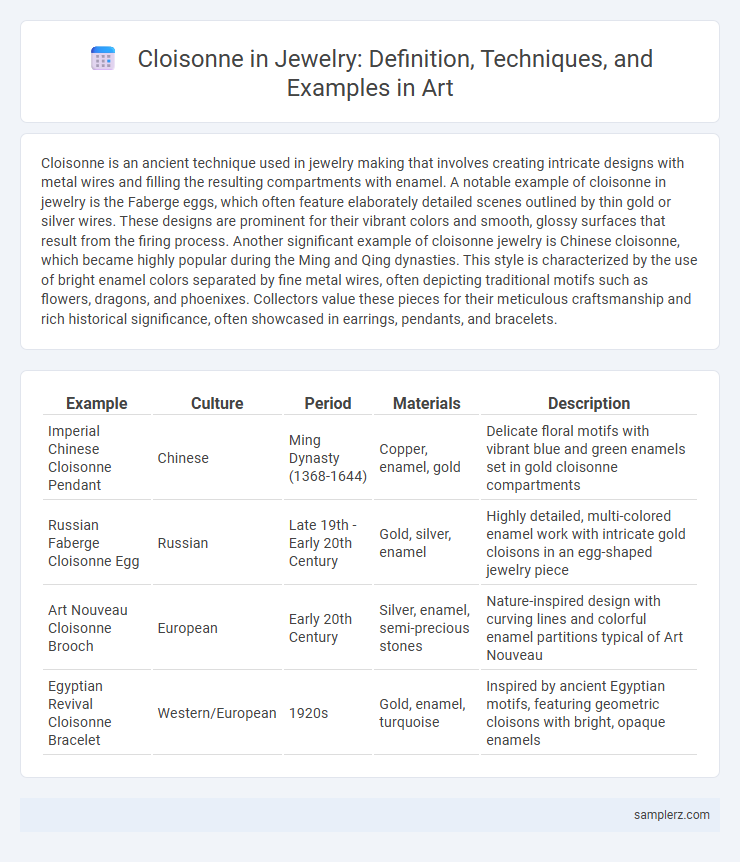Cloisonne is an ancient technique used in jewelry making that involves creating intricate designs with metal wires and filling the resulting compartments with enamel. A notable example of cloisonne in jewelry is the Faberge eggs, which often feature elaborately detailed scenes outlined by thin gold or silver wires. These designs are prominent for their vibrant colors and smooth, glossy surfaces that result from the firing process. Another significant example of cloisonne jewelry is Chinese cloisonne, which became highly popular during the Ming and Qing dynasties. This style is characterized by the use of bright enamel colors separated by fine metal wires, often depicting traditional motifs such as flowers, dragons, and phoenixes. Collectors value these pieces for their meticulous craftsmanship and rich historical significance, often showcased in earrings, pendants, and bracelets.
Table of Comparison
| Example | Culture | Period | Materials | Description |
|---|---|---|---|---|
| Imperial Chinese Cloisonne Pendant | Chinese | Ming Dynasty (1368-1644) | Copper, enamel, gold | Delicate floral motifs with vibrant blue and green enamels set in gold cloisonne compartments |
| Russian Faberge Cloisonne Egg | Russian | Late 19th - Early 20th Century | Gold, silver, enamel | Highly detailed, multi-colored enamel work with intricate gold cloisons in an egg-shaped jewelry piece |
| Art Nouveau Cloisonne Brooch | European | Early 20th Century | Silver, enamel, semi-precious stones | Nature-inspired design with curving lines and colorful enamel partitions typical of Art Nouveau |
| Egyptian Revival Cloisonne Bracelet | Western/European | 1920s | Gold, enamel, turquoise | Inspired by ancient Egyptian motifs, featuring geometric cloisons with bright, opaque enamels |
Historical Overview of Cloisonné Jewelry
Cloisonne jewelry, an ancient technique dating back to the Byzantine Empire around the 6th century, involves creating intricate designs with metal wires filled with enamel. This art form flourished during the Ming Dynasty in China, where artisans developed highly detailed and colorful patterns used in bracelets, pendants, and rings. Cloisonne's enduring legacy is evident in its use across various cultures, showcasing a blend of artistic craftsmanship and historical significance.
Techniques Used in Cloisonné Jewelry Making
Cloisonne jewelry making involves creating intricate designs by soldering fine metal wires onto a metal base to form compartments, or cloisons, which are then filled with vitreous enamel. The enamel is carefully kiln-fired multiple times to achieve a smooth, glossy surface that enhances the vibrant colors and detailed patterns. Techniques such as precise wire shaping, meticulous enamel layering, and controlled firing temperatures are essential to produce the durable and visually striking finish characteristic of cloisonne jewelry.
Iconic Cloisonné Jewelry Pieces Through History
Iconic cloisonne jewelry pieces include the exquisite Qing Dynasty Chinese bracelets, featuring vibrant enamel compartments separated by fine gold wires. Byzantine cloisonne crosses showcase intricate religious symbolism with colorful, detailed enamel work on precious metals. Art Nouveau cloisonne brooches by artists like Rene Lalique highlight fluid designs and natural motifs, combining artistic innovation with traditional cloisonne techniques.
Cloisonné in Ancient Chinese Jewelry
Cloisonne in Ancient Chinese jewelry exemplifies intricate craftsmanship using metal wires to create compartments filled with enamel, resulting in vibrant, detailed designs often featuring dragons and floral motifs. This technique reached its peak during the Ming Dynasty, producing exquisite robes, bracelets, and pendants that symbolized status and power. Ancient Chinese cloisonne pieces are prized for their durability, vivid colors, and historical significance in the evolution of enamel art.
Contemporary Artists Embracing Cloisonné
Contemporary artists like Ayala Bar and Stephen Masty have revived cloisonne in jewelry by blending traditional enamel techniques with modern design aesthetics. These creators utilize fine metal wires to outline vibrant enamel compartments, resulting in intricate, colorful pieces that emphasize craftsmanship and innovation. The resurgence of cloisonne reflects a broader trend of incorporating historical art forms into contemporary wearable art.
Symbolism and Motifs in Cloisonné Adornments
Cloisonne jewelry often features symbolic motifs such as lotus flowers representing purity and phoenixes symbolizing rebirth, reflecting cultural beliefs embedded in the art form. The use of intricate wire compartments allows artisans to create vibrant scenes that convey spiritual and historical narratives. These motifs not only enhance aesthetic appeal but also serve as visual storytelling elements that connect wearers to tradition and meaning.
Regional Variations in Cloisonné Jewelry Styles
Cloisonne jewelry showcases distinct regional variations, with Chinese cloisonne featuring intricate floral patterns and vibrant enamel colors, reflecting centuries-old traditional techniques. Japanese cloisonne is renowned for its refined, translucent enamels and subtle gradients, epitomized by styles such as Shippo and musen cloisonne. Russian cloisonne jewelry often incorporates bold, geometric designs with rich jewel tones, highlighting influences from Byzantine and Orthodox art traditions.
Care and Preservation of Cloisonné Jewelry
Cloisonne jewelry, known for its intricate enamel inlays separated by fine metal wires, requires careful handling to prevent chipping and discoloration. Store pieces in a soft, dry cloth or padded jewelry box away from direct sunlight and moisture to maintain the vibrant colors and prevent tarnishing of the metal framework. Regular cleaning with a gentle, non-abrasive cloth helps preserve the enamel's glossy finish without damaging the delicate cloisonne design.
Collecting Cloisonné Jewelry: Tips and Trends
Collecting cloisonne jewelry involves identifying high-quality enamel work with vibrant colors and intricate metal partitions. Trends favor vintage pieces from the Ming and Qing dynasties, prized for their craftsmanship and historical value. Expert collectors prioritize authentic markings and preservation state to ensure investment-worthy additions.
Cloisonné Jewelry in Modern Fashion and Design
Cloisonne jewelry, characterized by its enamel-filled compartments bordered by fine metal wires, remains a striking element in modern fashion and design. Contemporary designers incorporate vibrant enamel colors and intricate metalwork to create statement pieces that blend traditional craftsmanship with avant-garde aesthetics. This fusion highlights cloisonne's versatility, making it a sought-after technique in luxury accessories and haute couture collections.

example of cloisonné in jewelry Infographic
 samplerz.com
samplerz.com